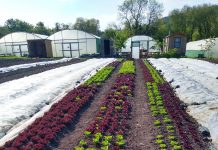Whatever time of year you go out for a meal, there seem to be French beans on the plate somewhere, so let’s try and grow our own. They originated in South America, and need as much warmth as the English climate allows.
Seeds and plants like it warm and moist, the soil really has to be at full summer heat for them to flourish. Transplanting in late May or early June is best, as they grow away strongly and shrug off the slugs.
For a good start it makes sense to sow the seeds 2” deep in a 3” deep container or module tray in a greenhouse, and transplant 3 weeks later. Since we have had a polytunnel we do one earlier sowing in mid March and pick beans by June, with a much heavier crop in the extra heat. If the soil is dry at flowering time, moisten the soil to encourage set of fruit.
A big decision is whether to plant dwarf or climbing varieties. Dwarfs need no support and crop a week earlier than climbers, although their pods can get soiled and nibbled by slugs. 15-18” spacing in full sun is best. As with all types of bean, close spacing gives you plenty of leaf but less fruit. Tendergreen is a favourite and also Sonesta, whose yellow beans are easier to see, although all French beans go green when cooked.
Picking pods when small will help keep the plant flowering, but the second crop on dwarfs is smaller and more erratic in quality. A second sowing in June to early July will give another crop in September to October.
Climbing varieties are a pleasing spectacle in the garden, easier to pick and crop for much longer. We grow them up circular 8’ bamboo wigwams and empty a bucket of manure in the middle to feed and keep the soil moist. Cobra is our favourite, long harvests and long beans.
An interesting climbing variety is Borlotto, which you can pick normally, or leave to ripen as haricot beans inside the pods. The pods ripen to a beautiful striped yellow and red, and you can eat the haricots fresh or dry them for winter use. Last year we had 1.3 kg of dried beans off 10 plants sown on 15 May and grown up a 4 foot diameter wigwam.
It is easy to keep your own seed as for some reason these beans rarely cross pollinate, even at a close distance. And when is the moon not hungry? When it’s full.
What to sow in May:
Virtually all summer crops can be sown this month if you haven’t already, although it is risky to plant out heat lovers like courgette and French beans until late in the month. Also winter cabbage and purple sprouting and second crops of lettuce and beetroot.








